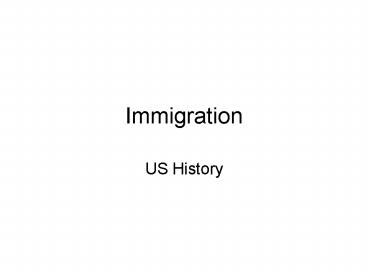Immigration - PowerPoint PPT Presentation
1 / 21
Title: Immigration
1
Immigration
- US History
2
Nation of Immigrants
- Always has been a nation of immigrants
- After Civil War, industrialization brought even
more immigrants. - 1865-1900 13.5 million people from abroad.
- 1920s immigration slows down.
3
Three Waves
- Colonial Immigration (to 1776)
- Old Immigration (1776-1850)
- New Immigration (1850-1924)
4
Colonial Immigration
- From arrival of Europeans to Declaration of
Independence. - In North America, mostly English, but also
Scotch-Irish, German, Swedish, Dutch. - Many Africans.
- Why?
- Europeans political and religious freedom
economic improvement. - Africans forced
5
Old Immigration
- 1776-1850
- From Northern and Western Europe Ireland,
Germany, Scandinavia - Why?
- Irish Potato famine in late 1840s.
- Germans wars and failed revolution in 1848.
- In general, economic opportunity.
6
Old Immigration
- Areas of Settlement
- Irish Northeastern cities (5-point area of NYC)
- Germans and Scandinavians Some cities mostly
farms in west
7
Old Immigration
- Problems Old Immigrants faced
- Irish and German Catholics experienced resentment
from Protestant establishment. - Also fear of economic competition.
8
New Immigration
- 1850-1924
- Shift in immigration to southern and eastern
Europe (Italy, Russia, Poland, Greece, Armenians)
as well as Asia (Japan, China) - Why?
- Again economic opportunity, political freedom.
- Religious freedom (Jews in Russia faced pogroms)
9
(No Transcript)
10
New Immigration
- Most new immigrants settled in cities
- Industrial centers, ports
- Concentrated in ghettos
- Urban area, usually poor, dominated by a single
ethnic group. - In NYC Lower East Side - Jewish Little
Italy Chinatown
11
New Immigration
- Chinese Immigration to US
- China overcrowded food shortages Taiping
Rebellion (1850) - US Gold Rush Central Pacific RR advertised for
workers on transcontinental RR
12
New Immigration
- Japanese Immigration
- Between 1900-1910
- Rapid industrialization disrupted Japanese
economy Japanese looked to US for a start over - 1910 Angel Island in SF Bay
- Immigrants waited for weeks or months for
immigration hearings.
13
Reaction to Immigration
- Nativism belief that native-born Americans were
superior to immigrants. - 1880s-90s Nativism emerged even among descendants
of Old Immigrants. - Believed that immigrant languages, religions and
traditions impacted American society negatively. - Nativist workers feared low wages and loss of
jobs. - Much discrimination, prejudice, stereotypes.
14
Reaction to Immigration
- Nativist legislation!
- 1850s Know-Nothing Party tried to limit voting
strength of immigrants to keep Catholics out of
office to require lengthy residence before
citizenship. - Unsuccessful party died out in late 1850s.
15
Reaction to Immigration
- Chinese Exclusion Act (1882)
- Using Wilhelm IIs phrase Yellow Peril
- Common in newspapers owned by William Randolph
Hearst on West Coast - California barred Chinese from owning property or
working in certain jobs. - Congress followed suit by limiting Chinese
immigration.
16
Reaction to Immigration
- Gentlemans Agreement (1907)
- Pres. Theodore Roosevelt reached informal
agreement with Japan to halt emigration of its
people to US.
17
Reaction to Immigration
- Literacy Tests (1917)
- Congress barred immigrants who could not read or
write in their own language.
18
Reaction to Immigration
- Emergency Quota Act (1921)
- Limited number of immigrants to US each year to
350,000. - National Origins Quota Act (1924)
- Further reduced immigration.
- Favored immigrants from northern and western
Europe. - National Origins Act (1929)
- Limited number to 150,000 per year.
19
Immigrants and American Society
- Sociological theories on absorption of immigrants
into a society - Melting Pot
- people from various cultures meet in a place and
form a new culture. Difficult to distinguish
contributions of any one culture.
20
Immigrants andAmerican Society
- Assimilation
- Immigrants become like the established American
culture they give up languages and customs for
the dominant society. - Immigrants from Africa, Asia, Caribbean who
looked least like nativists had hardest time
assimilating.
21
Immigrants andAmerican Society
- Pluralism (salad bowl or mosaic)
- No group really loses its distinctive
characteristics. - People live side by side with each group
contributing in its own way.


























![Top 10 Best Immigration Consultants in India [2022] PowerPoint PPT Presentation](https://s3.amazonaws.com/images.powershow.com/9740716.th0.jpg?_=202203300711)




